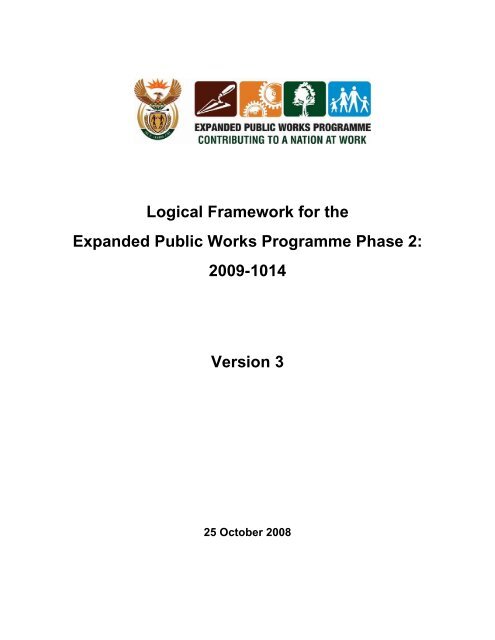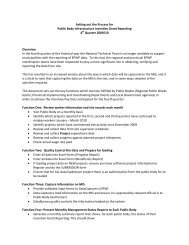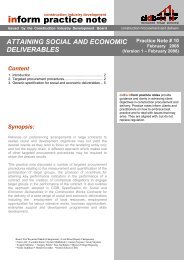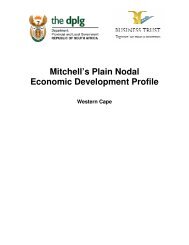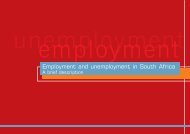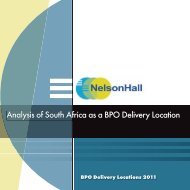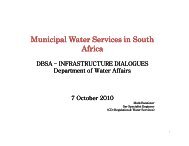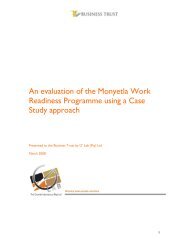Logical Framework for the Expanded Public Works ... - Business Trust
Logical Framework for the Expanded Public Works ... - Business Trust
Logical Framework for the Expanded Public Works ... - Business Trust
Create successful ePaper yourself
Turn your PDF publications into a flip-book with our unique Google optimized e-Paper software.
<strong>Logical</strong> <strong>Framework</strong> <strong>for</strong> <strong>the</strong><strong>Expanded</strong> <strong>Public</strong> <strong>Works</strong> Programme Phase 2:2009-1014Version 325 October 2008
Figure 2: Overview of detailed process to develop Overall and Sector LogframesProcess to develop Overall LogframeProcess to develop Sector LogframesFirst draft developed by <strong>the</strong>Technical Team – 22 SeptSecond draft developed by <strong>the</strong>Steering Committee – 6 & 7 OctDevelop action plans toaddress programme gapsSector workshops to agree on Sub‐Programmes and develop logframes20 October 08 – Feb 09Revise Overall Logframe so as to beconsistent with Sector LogframesDec 08 – Feb 09Submit final draft log frame and businessplan to Cabinet Legotla15 December 08Developaction plansto addresssub‐prog/sector gapsSign off Sector Logframes ‐ March 093. EPWP 2 - Proposals and TerminologyIt is proposed that EPWP 2 is implemented so as to create two types of employment namely:• Ongoing employment: which is indefinite term work opportunities that are linked to skills andcareer development.• Short term employment: which is fixed duration or short term work opportunities.These employment methods will be implemented through sub programmes undertaken by <strong>the</strong> threespheres of Government [National, Provincial and Local] and State Owned Enterprises usingImplementers fulfilling <strong>the</strong>ir normal mandates. Implementers are Departments, directorates, divisionsand agencies within <strong>the</strong>se public bodies, who have line accountability <strong>for</strong> <strong>the</strong> mandate and control <strong>the</strong>budget in respect of <strong>the</strong> mandate <strong>for</strong> <strong>the</strong> service or project being implemented under <strong>the</strong> Sub‐Programme. Such Implementers are required to align <strong>the</strong>ir normal projects and programmes with <strong>the</strong>EPWP in a manner whereby <strong>the</strong>y will fulfill <strong>the</strong>ir mandates, while at <strong>the</strong> same time achieve EPWPoutputs. Sub‐Programmes will be implemented in each Sector and Sector Lead Departments will supportImplementers to implement Sub‐Programmes so as to be better aligned with <strong>the</strong> EPWP.The programme management structure envisaged is shown in Figure 3 below.<strong>Logical</strong> framework <strong>for</strong> EPWP 2: Version 3: 25 October 2008 6
Figure 3: Programme management structureEPWP – cross cuttingnational programmePresidencyOverall directionand supportEPWP Unit – DPWNational LineDepartmentsProvinces Municipalities State OwnedEnterprises/EntitiesSub‐Programmes and Sub‐Programme ManagersProjects and programmes undertaken by ImplementersSupport to Sub‐ProgrammeManagers andimplementers insectorSector LeadDepartments<strong>Logical</strong> framework <strong>for</strong> EPWP 2: Version 3: 16 October 2008 7
4. Goal and purpose of EPWP 2GoalTo create 4,5 million? (short and ongoing) work opportunities 1 <strong>for</strong> poor and unemployed people in South Africa so as to contribute tohalving unemployment by 2014, through <strong>the</strong> delivery of public and community services. (This will scale up from 500,000 per year in2009/10 to 1.5 million in 2013/14)Purpose<strong>Public</strong> bodies from all spheres ofgovernment (in terms of <strong>the</strong>ir normalmandates and budgets) and <strong>the</strong> Non Statesector (supported by governmentincentives), deliberately optimize <strong>the</strong>creation of work opportunities <strong>for</strong>unemployed and poor people in SouthAfrica through <strong>the</strong> delivery of public andcommunity services. Training andenterprise development will beimplemented in sub‐programmes toenhance service delivery and beneficiarywell‐being.Indicators1. X no. of work opportunities (work opportunities, people employed and full‐time equivalents)created per annum in EPWP Programmes as follows:• Year 1 (2009/10) – no of work opportunities/people employed/full time equivalents• Year 2 (2010/11) – no of work opportunities /people employed/full time equivalents• Year 3 (2011/12) – no of work opportunities /people employed/full time equivalents• Year 4 (2012/13) – no of work opportunities /people employed/full time equivalents• Year 5 (2013/14) – no of work opportunities /people employed/full time equivalents2. Impact on unemployment ‐ geographic target to be investigated3. Overall Participation targets per annum starting from <strong>the</strong> following Y1:• At least 55% of workers are women• At least 40% of workers are youth• At least 3% of workers are disabled(Investigate scaling up over time)Sub‐programme targets to be developed4. Government and Non State sector service delivery provided to approved and definedstandards.5. (Increased) proportion of normal budget spent on EPWP outputs [work opportunities, peopleemployed, training and income transferred]6. Sub programme targets specified where applicable;• % of labour intensive employment• Number of people trained• Number of SMME established and operational1 A work opportunity is paid work created <strong>for</strong> an individual <strong>for</strong> any period of time. The same individual can be employed on different projects and each period of employment is counted as a workopportunity.<strong>Logical</strong> framework <strong>for</strong> EPWP 2: Version 3: 16 October 2008 11
5. Key Result Areas5.1 Result Areas1. Enabling : An enabling environment <strong>for</strong> <strong>the</strong> EPWP is established.2. Leading : The EPWP Programme is led, managed and supported.3. Per<strong>for</strong>mance management : The accountability and per<strong>for</strong>mance management of <strong>the</strong> EPWP is streng<strong>the</strong>ned across government.4. Implementing: National Government Departments, Provinces, Municipalities, <strong>Public</strong> bodies and <strong>the</strong> Non‐State sector deliver <strong>the</strong>ir mandate within<strong>the</strong> EPWP framework <strong>the</strong>reby creating work opportunities <strong>for</strong> <strong>the</strong> poor.5. Reporting:. EPWP progress (outputs) is monitored and reported and its impact evaluated and reviewed on a consistent and comprehensive basis.6. Communicating : The progress and impact of <strong>the</strong> EPWP is consistently communicated to all stakeholders.<strong>Logical</strong> framework <strong>for</strong> EPWP 2: Version 3: 16 October 2008 12
5.2 Result Areas : Objectives and target groupsKey Results Objectives Critical Target Groups1. An enablingenvironment <strong>for</strong> <strong>the</strong>EPWP is established2. The EPWPProgramme is led,managed andsupported1. To have in place a clear set of special employment conditions in terms of short and ongoing termwork.2. To align <strong>the</strong> National Youth Service (NYS) framework to <strong>the</strong> EPWP so at to maximise value toboth programmes.3. To align disability and gender frameworks to <strong>the</strong> EPWP4. To establish and obtain a common understanding on clear funding and budgeting protocols, inorder to enable <strong>the</strong> scaling up of existing and <strong>the</strong> establishment of new programmes5. To work with sectors to clarify and refine <strong>the</strong> funding grants applicability to sectors.6. To administer <strong>the</strong> additional funding <strong>for</strong> compliant per<strong>for</strong>ming EPWP programmes to establish aframework <strong>for</strong> intergovernmental protocols <strong>for</strong> <strong>the</strong> EPWP7. To establish an explicit per<strong>for</strong>mance targeting process in respect of EPWP programmes andfunding allocations8. To investigate <strong>the</strong> basis by which geographic targeting can be assessed.9. To review and refine <strong>the</strong> training framework which enables sub‐programmes to clearly define<strong>the</strong>ir training requirements and to access funding and training service providers10. To review and refine an enterprise development framework which enables sub‐programmes toclearly define <strong>the</strong>ir enterprise development requirements and to access funding and support11. To establish a clear and supported set of institutional arrangements <strong>for</strong> <strong>the</strong> leadership, funding,implementation and reporting of <strong>the</strong> EPWP [within <strong>the</strong> context of <strong>the</strong> cross cutting nature andpriorities of <strong>the</strong> EPWP]1. Political leadership champion <strong>the</strong> EPWP and <strong>the</strong> achievement of its targets2. To clarify, communicate and operationalise concepts and parameters of <strong>the</strong> EPWP and how<strong>the</strong>se apply to <strong>the</strong> implementation of core mandate programmes or projects with linked ‘EPWPoutcomes’ on a consistent and appropriate basis.3. To provide support in <strong>the</strong> design and implementation of sub‐programmes and assist subprogrammesto secure <strong>the</strong> required financial resources and programme management capacity4. To identify and or respond to innovative opportunities <strong>for</strong> expanded service delivery which willgenerate increased work opportunity outcomes5. To identify and disseminate key learnings in respect of <strong>the</strong> EPWP and enhance capacity toimplement <strong>the</strong> EPWP6. To adapt programme design based on learnings and analysis of current per<strong>for</strong>mance7. To develop standardised programme elements such as training programmes, proceduresmanuals and business processes, to enable <strong>the</strong> economy of scale benefits of programmes to berealised across government departments and municipalities8. To establish an effective technical support mechanism and programme• National Treasury• NEDLAC• Department of Labour• Office of <strong>the</strong> Presidency• Department of <strong>Public</strong>Service Administration• Cabinet; PortfolioCommittee• Minister of DPW• Premiers• MinMec• Mayoral Committees• DPW• National Line Departments• Provincial Line Departments• Provincial Treasuries• Local Government: Metros;DMs and LMs<strong>Logical</strong> framework <strong>for</strong> EPWP 2: Version 3: 16 October 2008 13
Key Results Objectives Critical Target Groups1. To establish a target based management process2. To agree targets with National Departments, Provinces, Municipalities and SOEs3. To ensure that all spheres of government report against <strong>the</strong> targets set4. To provide financial incentives in terms of <strong>the</strong> achievement of targets3. The accountabilityand per<strong>for</strong>mancemanagement of <strong>the</strong>EPWP isstreng<strong>the</strong>ned acrossgovernment4. NationalGovernmentdepartments,provinces,municipalities, publicbodies and <strong>the</strong> Non‐State sector deliver<strong>the</strong>ir mandate within<strong>the</strong> EPWP <strong>Framework</strong><strong>the</strong>reby creating workopportunities <strong>for</strong> <strong>the</strong>poor.5. EPWP progress(outputs) is monitoredand reported and itsimpact evaluated andreviewed on aconsistent andcomprehensive basis.6. The progress andimpact of <strong>the</strong> EPWP isconsistentlycommunicated to allstakeholders1. Sub programmes determine and specify <strong>the</strong> basis by which <strong>the</strong>y will achieve EPWP outputs andare <strong>for</strong>mally recognised as EPWP linked programmes.2. All Spheres of Government and State Owned Entities develop EPWP plans to achieve agreedEPWP targets, using recognised EPWP linked sub‐programmes that are delivered as part of<strong>the</strong>ir normal mandate.3. Each identifiable sub‐programme within <strong>the</strong> relevant sphere allocates <strong>the</strong> necessary budgetand additional funding in order to achieve its defined EPWP outputs and contribute to <strong>the</strong>applicable Government Sphere or Entities.4. Each identifiable sub‐programme has a clearly defined programme management approach anddevelops <strong>the</strong> capacity to implement it5. To develop reporting protocols against which sub‐programmes can be measured in terms of <strong>the</strong>achievement of <strong>the</strong> agreed EPWP outputs1. To review and revise <strong>the</strong> EPWP M&E framework which defines key dimensions <strong>for</strong> monitoringand evaluating sub programmes, as well as <strong>the</strong> general allocation of roles and responsibilities<strong>for</strong> data collection, verification and reporting.2. To institutionalise M&E and reporting functions at sub‐programme and national level3. To establish protocols to improve <strong>the</strong> efficiency of data transfer from sub‐programmes to <strong>the</strong>national EPWP4. To provide analysis and reports to identified and agreed stakeholders on a regular basis linkedto <strong>the</strong> targets of <strong>the</strong> sub‐programmes5. To commission evaluation research and to on an ongoing basis assess <strong>the</strong> impact of <strong>the</strong> EPWP1. To clearly communicate <strong>the</strong> changed goal and purpose of <strong>the</strong> EPWP and how it operates to allstakeholders which reflects <strong>the</strong> EPWP 2 proposals2. To clearly communicate <strong>the</strong> progress and per<strong>for</strong>mance of <strong>the</strong> EPWP to all stakeholders3. To establish a sub‐programme specific communication mechanism to beneficiaries4. To establish a common, highly visible and recognisable brand <strong>for</strong> <strong>the</strong> EPWP5. To recognise innovation and best practice• National Line Departments• Provincial Line Departments• Provincial Treasuries• Local Government: Metros;DMs and LMs• DPW• All government agencieswith implementationresponsibilities• All government agencieswith a role in subprogramme coordination• All Non State sectoragencies withimplementationresponsibilities• Presidency• Cabinet• MinMec• National Treasury• Implementing Agencies:government and civil society• EPWP ProgrammeManagement (EPWP Unit)• Cabinet• Senior Political Leadershipthroughout <strong>the</strong> Country• Government officials inimplementing programmes• General <strong>Public</strong>• <strong>Business</strong>• Labour• Beneficiaries<strong>Logical</strong> framework <strong>for</strong> EPWP 2: Version 3: 16 October 2008 14
6. Comparison between EPWP 1 and EPWP 2The table below shows a comparison between <strong>the</strong> first and second phases of <strong>the</strong> EPWP.EPWP 1 EPWP 2Over <strong>the</strong> first five years to createtemporary work opportunities andincome <strong>for</strong> at least 1 million unemployedSouth Africans.To provide needed public goods andservices, labour‐intensively, atacceptable standards, through <strong>the</strong> use ofmainly public sector budgets and publicand private sector implementationcapacityTo increase <strong>the</strong> potential <strong>for</strong> at least 14%of public works participants to earnfuture income by providing workexperience, training and in<strong>for</strong>mationrelated to local work opportunities,fur<strong>the</strong>r education and training andSMME developmentExit strategies will be developed <strong>for</strong> eachsector and will identify possible exitroutes <strong>for</strong> workers once <strong>the</strong>y leave <strong>the</strong>EPWP programmes. Opportunitiesinclude possible longer‐termemployment, self‐employment, orfur<strong>the</strong>r education or training. These exitstrategies will in<strong>for</strong>m <strong>the</strong> trainingprovided to beneficiaries under <strong>the</strong>programme.To create 4,5 million? (short and ongoing) work opportunities<strong>for</strong> poor and unemployed people in South Africa so as tocontribute to halving unemployment by 2014, through <strong>the</strong>delivery of public and community services. (This will scale upfrom 500,000 per year in 2009/10 to 1.5 million in 2013/14?)<strong>Public</strong> bodies from all spheres of government (in terms of<strong>the</strong>ir normal mandates and budgets) and <strong>the</strong> Non Statesector (supported by government incentives), deliberatelyoptimizes <strong>the</strong> creation of work opportunities <strong>for</strong> unemployedand poor people in South Africa through <strong>the</strong> delivery ofpublic and community services.Training and enterprise development will be implemented insub‐programmes to enhance service delivery and beneficiarywell‐being.None<strong>Logical</strong> framework <strong>for</strong> EPWP 2: Version 3: 16 October 200815


